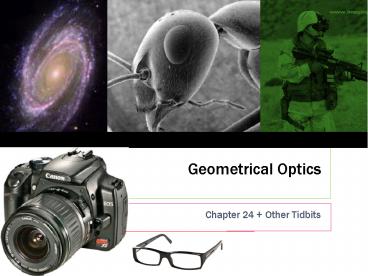Geometrical Optics - PowerPoint PPT Presentation
Title:
Geometrical Optics
Description:
Geometrical Optics Chapter 24 + Other Tidbits * On and on and on This is a short week. Schedule follows So far, no room available for problem session. – PowerPoint PPT presentation
Number of Views:386
Avg rating:3.0/5.0
Title: Geometrical Optics
1
Geometrical Optics
- Chapter 24 Other Tidbits
2
On and on and on
- This is a short week.
- Schedule follows
- So far, no room available for problem session.
Still working on it. - Today we try to complete lenses.
- Quiz on Friday?
3
November 2009 November 2009 November 2009 November 2009 November 2009 November 2009 November 2009
Sunday Monday Tuesday Wednesday Thursday Friday Saturday
22 23 COMPLETE THINLENSPROBLEMS SOLVING 25 Interference Diffraction 26 THANKSGIVING 27 THANKSGIVING HOLIDAY 28
29 30 Interference Diffraction
December 2009 December 2009 December 2009 December 2009 December 2009 December 2009 December 2009
Sunday Monday Tuesday Wednesday Thursday Friday Saturday
1 REVIEW SESSION If Room is Available NO ROOM AVAILAVLE 2 EXAMINATION 4 3 4 INTERFERENCE DIFFRACTION 5
6 7 OVERVIEW OFCOURSE LAST DAY OF CLASS 8 9 10 11 12 FINAL EXAM
4
Most important case converging lensObject to
left of F1
5
Most important case converging lens
6
Most important case converging lens
7
Most important case converging lens
8
Most important case converging lens
So, now you know!
9
Aberrations are imperfections in the optical
image formed by a spherical lens (or optical
mirror). There are five main aberrations1.
Chromatic aberration. The refractive index of
glass varies with wavelength. This results in
different focal lengths and image magnifications
for different colours.2. Spherical aberration.
Lenses with spherical surfaces have a shorter
focal length at their periphery than at their
centre.3. Coma. The various circular zones of a
lens produce an image of an off-axis point that
is distorted radially into a comet shape known as
a coma patch.4. Curvature of field. The focal
surface is not a plane but a bowl shape.5.
Astigmatism. Because a lens appears asymmetric to
an off-axis beam, the image of a point is not a
point but a short line radial from, or tangential
to, the optic axis of the lens. These images are
formed in different planes.6. Distortion. The
image magnification is greater towards the edges
of the field (pincushion distortion) or less
(barrel distortion) than at its centre.
10
Remember the Spectrum?
11
Dispersion
- Index of refraction depends on the wavelength, or
color. - f depends on the index of refraction.
12
Chromatic Aberration
13
Example
14
Correction achromatic lens couple
15
(No Transcript)
16
Spherical Aberration
- Results from the assumption of paraxial
conditions. - Real lenses need a wider opening, larger
apertures.
17
Spherical Aberration - Correcting
18
Barrel Distortion
19
Coma
20
Some useful stuff
21
Diaphram
IntensityArea
22
Camera
- The intensity of the light striking the film or
CCD array is proportional to the area of the
lens. - This is adjusted by the photographer by means of
the aperture or diaphragm control. - f-number is defined by
- Ex A lens of focal length f50mm and an aperture
diameter of 25mm has an f number of 2, often
written as f/2
23
f stops
Multiplier sqrt(2) Designation
sqrt(2)2 2.0 f/2
sqrt(2)3 2.8 f/2.8
sqrt(2)4 4.0 f/4
sqrt(2)5 5.6 f/5.6
sqrt(2)6 8.0 f/8
sqrt(2)7 11.1 f/11
sqrt(2)8 16.0 f/16
24
More on Camera
25
The Microscope









![L 32 Light and Optics [3] PowerPoint PPT Presentation](https://s3.amazonaws.com/images.powershow.com/7515468.th0.jpg?_=20210330103)





















